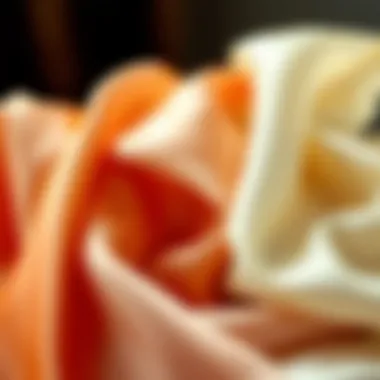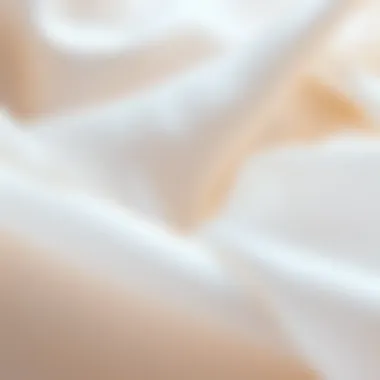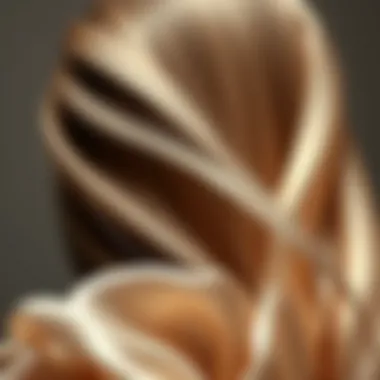Choosing the Best Silk for Healthy Hair


Intro
Silk has long been revered for its luxurious feel and aesthetic appeal. When it comes to hair care, the conversation surrounding silk often centers on its benefits for hair health. In this exploration, we will dissect the characteristics of various silk types and showcase why mulberry silk stands head and shoulders above its peers. The intricacies of silk influence not just appearance but the overall condition of our hair. With a proper understanding, you can navigate the silk landscape with confidence, ensuring that each choice aligns with your hair care goals.
Tips and How-Tos
Taking good care of your hair is no cakewalk. It needs the right products and techniques, and silk, especially the luxurious mulberry, can play a crucial role in that equation. Here’s how you can effectively incorporate silk into your hair care routine:
Haircare and Styling Basics
- Choosing Silk Products: Opt for silk pillowcases, hair wraps, and scrunchies made of high-quality mulberry silk. Unlike other silk varieties, mulberry silk is known for its smooth finish, which helps reduce friction on hair strands.
- Maintaining Hair Moisture: The moisture-retaining properties of mulberry silk can help prevent dryness. When going to bed, make sure to tie your hair in a loose style with a silk scrunchie to minimize breakage and keep natural oils where they belong.
- Washing Techniques: Use a gentle shampoo suited to your hair type. Afterward, condition thoroughly and consider wrapping your hair in a silk scarf as it dries. This method prevents moisture loss and reduces frizz.
- Avoiding Hair Damage: Transition away from cotton to silk accessories wherever possible. This shift plays a significant role in reducing hair tangles and split ends.
Skincare Routines for Different Skin Types
While the focus here is mainly on silk's impact on hair, it's important to remember that skin and hair often share a relationship. Choosing silk can also enhance your skin care routine:
- Dry Skin: Silk’s natural properties help maintain skin hydration, reducing dryness overnight.
- Oily Skin: A silk pillowcase can help control oil absorption, leading to fewer breakouts.
Sustainable Practices
In a world increasingly conscious of sustainability, making choices that reflect eco-friendly practices is paramount. Silk, particularly when sourced responsibly, can align with a sustainable lifestyle.
Eco-Friendly Fashion Brands
Brands like SLIP and Lunya offer a range of silk products made from ethically sourced materials, supporting both environmental and social responsibility.
Tips for Sustainable Grooming
- Invest in Quality: Rather than frequent tenders of low-quality alternatives, invest in high-quality silk that will last and offer maximum benefits for your hair.
- Care Guidelines: Follow washing and caring instructions carefully to extend the life of your silk items.
Celebrating Diversity in Beauty
Beauty and hair care are influenced by cultural narratives and personal choices. Different cultures regard silk in unique ways, and it’s important to recognize and celebrate these perspectives.
Inclusive Beauty Brands
Look for brands that support diversity, such as Curlsmith and Mielle Organics, which cater to various hair textures and types while incorporating silk in their formulations.
Cultural Influences on Fashion
Silk has rich histories tied to diverse cultures around the globe. Understanding these narratives adds depth to the use of silk in beauty routines.
In summary, selecting the right silk for your hair care process transcends mere aesthetics—it's a commitment to enhancing hair health and embracing sustainable practices. From understanding the nuances of different silk types to incorporating eco-friendly choices, this guide aims to elevate your silk experience and fortify your hair care routine.
Understanding Silk and Its Origins
In the realm of hair care, the significance of silk cannot be understated. Recognizing the origins and intricacies of silk production lays the groundwork for understanding why some silks are deemed superior for hair health. To the untrained eye, all silk may appear the same; however, a closer look reveals a rich tapestry of types, each with its own distinct properties and benefits.
The Intricacies of Silk Production
Silk, often celebrated as a luxurious fabric, begins its journey from the silkworm. The most renowned type of silk, mulberry silk, is meticulously produced using the larvae of the Bombyx mori moth. These little creatures feast on mulberry leaves, growing until they spin their cocoons, which are then harvested with care. The process itself is no cakewalk; it requires an environment carefully controlled, where temperature and humidity are just right to ensure quality.
However, the process doesn't stop at harvesting. The extraction of silk fibers from the cocoons involves boiling and unwinding, a delicate dance that ensures the strands are intact without harming the surrounding fibers. This labor-intensive process is a testament to the craftsmanship behind silk production. For those invested in hair care, understanding these production nuances helps appreciate why mulberry silk commands such respect in the industry.
Types of Silk and Their Characteristics


Choosing the right silk means recognizing the differences between various types. Each type possesses unique traits that may or may not suit individual hair care needs.
Mulberry Silk
Mulberry silk is recognized for its unparalleled softness and sheen. The long fibers result in fewer loose threads and a smoother surface, making it a wise choice for maintaining hair health. Its hypoallergenic properties provide additional peace of mind for those with sensitive skin or allergies. Moreover, the production of mulberry silk is closely regulated, ensuring high quality every time.
In the realm of hair care, mulberry silk shines—literally and metaphorically. It helps reduce friction that can lead to breakage while promoting moisture retention in the hair. The only drawback? Its premium pricing, which might deter budget-conscious shoppers, though many would argue it’s worth every penny.
Wild Silk
Wild silk, often derived from insects that feed on a variety of plants beyond mulberry leaves, has a more textured feel compared to its mulberry counterpart. This silk has a characteristic roughness, which can provide grip, making it less slippery than mulberry silk. Some users appreciate this feature for styling, as their hair is less likely to slip off accessories.
However, the irregularity in texture can lead to inconsistent quality. While wild silk is often considered eco-friendly and sustainable, it doesn’t always deliver the same level of softness and sheen that mulberry silk does, which might be a dealbreaker for some seeking ultimate luxury in their hair care regimen.
Tussah Silk
Tussah silk, another variety that comes from wild silkworms, is known for being more robust and durable. It boasts a distinct golden hue and is often more affordable than mulberry silk. This silk is inherently breathable, allowing for temperature regulation, which can also be beneficial in maintaining hair health by preventing overheating.
However, while its durability is a plus, some may find it lacks the same level of smoothness, which can mean more friction when it comes to hair surfaces. Thus, for those with delicate hair, it might not be the ideal option compared to the luxurious feel of mulberry silk.
Other Silk Varieties
There are several lesser-known silk varieties that also contribute to the diverse world of silk fabrics. Some entail specific regional adaptations and processing techniques that may affect their characteristics. Generally, these other silk varieties tend to play a niche role in the hair care market.
They might offer unique textures or hues, yet their performance can be hit or miss. Often, they do not measure up to the gentleness and damage-reducing qualities of the more renowned silks, impacting their appeal in the hair care community. However, they can still be valued for specific styling needs or as alternatives that provide variety in texture.
In understanding silk, one can glean essential details about how the type of silk they choose significantly impacts their hair's condition. The journey from silkworm to silk pillowcase is not just a matter of aesthetics but also one of caring for one's hair effectively.
The Science Behind Silk and Hair Health
As we delve into the realm of silk and its implications for hair care, understanding the science behind silk's interaction with hair is essential. The intricate relationship between silk fibers and hair has significant impacts on texture, shine, and moisture retention. In this section, we will explore how these elements contribute to the overall health of hair and, in the process, help you make informed choices regarding silk products that are best suited for your individual hair care needs.
How Silk Affects Hair Texture
Silk's unique properties play a pivotal role in enhancing hair's texture. For many, the desired outcome is a silky, smooth finish that reflects light and exudes vitality.
Smoothness and Shine
When it comes to smoothness and shine, silk truly shines in the spotlight. The natural protein structure of silk fibers allows them to glide effortlessly over hair strands. This characteristic minimizes friction, which can lead to damage and dullness in hair. As a result, silk not only enhances the brightness of hair, but also leaves it feeling soft and luxurious.
A key feature of this smooth quality is its ability to create a barrier that reduces the absorption of moisture from humidity in the air. This means that on those sticky summer days, your hair does not revert to an unpredictable frizz ball. Silk supports a healthy shine, promoting a polished look that many desire. However, a downside to consider is that silk doesn't offer the same insulation as some heavier materials, possibly making it less effective in colder climates.
Reduction of Frizz
One of the most significant advantages of using silk in hair care is its capacity for frizz reduction. Frizz can be a persistent foe for many people, particularly those with curly or textured hair. Silk's smooth surface allows hair to slide instead of snagging, thus preventing the disruption of the hair cuticle that commonly leads to frizz.
The remarkable aspect of frizz reduction in silk lies in its ability to regulate moisture levels. This means that not only does it keep excess moisture from entering the hair shaft, but it also helps normal hair by preventing dehydration. A unique feature here is how silk supports hair elasticity, allowing curly or wavy styles to maintain their shape without becoming frizzy. However, it’s important to note that while silk can significantly reduce frizz, it might not be a magical cure-all for extremely high-humidity conditions.
Moisture Retention and Silk
Moisture retention is another critical facet of how silk contributes to overall hair health. Understanding how silk interacts with moisture can reveal why it's beneficial for various hair types.
Absorption Properties
Silk excels when it comes to absorption properties, specifically how it interacts with moisture. Unlike other materials, silk has an inherent ability to retain moisture without feeling damp to the touch. This means that silk can keep hair hydrated while maintaining an overall smooth texture.


The key characteristic of silk is that it helps balance the moisture levels in hair. This quality makes it an ideal option for individuals whose hair tends to dry out easily. By preventing excess moisture loss, silk helps maintain elasticity and reduces the risk of breakage. An important point to consider, though, is that this moisture retention can be less effective in extremely dry conditions, necessitating additional care products to achieve desired hydration levels.
Comparison with Other Fabrics
When making a decision about silk for hair care, comparing it to other common fabrics is essential. Most notably, cotton can absorb moisture too readily, often leading to frizz and dryness in hair.
In terms of moisture absorption, silk outperforms cotton and polyester, making it a preferred choice for hair care. On the flip side, while silk is beneficial, it can be more delicate than some synthetic alternatives, requiring careful handling and maintenance.
Overall, the comparison highlights that while silk is unparalleled in moisture retention, it does necessitate a nuanced approach to maintenance to ensure longevity and optimal performance in hair care routines.
With these insights into how silk affects hair texture and moisture retention, readers can better appreciate silk's role in hair care products and make educated decisions about incorporating silk into their routines.
Comparative Analysis of Silk Types
Analyzing different types of silk is crucial in the exploration of hair care. Each silk variety offers its unique strengths and weaknesses, influencing not only the choice of fabric but also the overall hair health and care regimen. This comparison will aid consumers by providing a better understanding of their options, while also addressing specific elements such as durability, cost, and hypoallergenic properties.
Mulberry Silk vs. Other Silks
Quality and Durability
Mulberry silk stands out primarily for its exceptional quality and durability. Its long fibers make it incredibly strong yet soft, providing a luxurious feel that many other silks lack. Compared to wild silks or tussah, mulberry silk tends to be more resilient against wear and tear. This quality ensures that a silk item can withstand regular use, offering not just comfort but longevity. Many women prefer mulberry silk pillowcases or bedding because they don’t lose their sheen or smoothness with laundering. However, they do come with a higher price tag, which can be a consideration for those on a tighter budget.
Another unique feature of mulberry silk's durability is its tight weave. This protects the fibers and minimizes snagging or fraying, making it a favored choice for those seeking long-lasting hair care products.
Cost Considerations
When considering cost, it's essential to note that mulberry silk is usually priced higher than its counterparts. The production of this silk involves careful cultivation and harvesting of silk moths, contributing to a more elevated cost. Those looking to invest in high-end silk items will find that the quality justifies the expense.
Nevertheless, there are budget-friendlier options. Wild silk, for instance, is less expensive but may not offer the same luxurious feel and durability as mulberry silk. In this context, potential buyers should weigh their needs against their budget, understanding that while cheaper options exist, the trade-off might be in performance and longevity.
Hypoallergenic Properties of Silk
Skin Sensitivities
The hypoallergenic nature of silk speaks volumes, especially for individuals who deal with skin sensitivities. Silk naturally repels dust mites, mold, and other allergens, which can be a game-changer for allergy sufferers. When it comes to hair care, using silk products means less irritation, leading to healthier scalps and hair environments. This property position silk as a preferred material for pillowcases, especially for women with sensitive skin conditions. Moreover, the smooth surface of silk reduces friction against the skin, minimizing potential outbreaks and irritation commonly caused by other fabrics.
Benefits for Different Hair Types
The advantages of silk extend to different hair types as well. People with curly or frizzy hair often find that silk’s smooth surface greatly reduces tangles and frizz, allowing for easier styling and less breakage. On the other hand, those with straight hair can benefit from increased shine and reduced static. Different types of silk can accommodate a variety of hair textures and needs, promoting enhanced hair health across the board.
In summary, when considering silk for hair care, understanding the comparisons between these types becomes vital. Each variety has distinct characteristics that serve particular needs and preferences, aiding in making an informed choice aligned with both lifestyle and budget.
Practical Applications of Silk in Hair Care
The applications of silk in hair care extend far beyond mere luxury. Silk plays a significant role in enhancing the health and appearance of hair, providing both protection and nourishment. By understanding the practical uses of silk, individuals can harness its benefits to maintain and improve hair quality over time. From pillowcases that reduce damage to stylish scarves that protect hair from environmental elements, each aspect of silk's application contributes positively to hair care routines.
Silk Pillowcases and Hair Preservation
Reducing Breakage
One of the standout benefits of silk pillowcases lies in their ability to reduce breakage. The smooth surface of silk minimizes friction between the hair and the fabric, which is crucial during sleep when hair is most vulnerable to damage. Unlike cotton, which can snag and pull at strands, silk allows hair to glide effortlessly, keeping it intact throughout the night.
This characteristic makes silk an attractive option for those looking to preserve their hairstyles and overall hair health. By reducing breakage, silk pillowcases can lead to longer, healthier hair, sparing the need for frequent trims and interventions.
However, it's important to choose high-quality silk, as lower-grade options may not provide the same level of slip and softness. The fine fibers of high-grade silk create a breathable environment, helping to maintain moisture as well.


Maintaining Styles Overnight
Another notable advantage of silk pillowcases is their effect on maintaining styles overnight. Women often invest time and effort into curling, straightening, or styling their hair, only to wake up to frizz and flattened locks. Silk helps combat this challenge by creating a hydrating and non-static surface for hair to rest on.
The unique feature of silk’s low absorbency allows it to retain the natural oils of the hair, thus preventing styles from falling flat. As a result, you wake up looking fresh, with less effort put into your morning routine. The practicality of silk in this context can't be overstated—it offers a simple solution to one of the most frustrating hair dilemmas.
Silk Scarves and Accessories
Styling Benefits
Silk scarves and accessories offer a plethora of styling benefits, making them a popular choice for fashion-forward individuals. The lightweight nature of silk allows it to be fashioned in various ways, whether draped around the neck or tied in a bun. Moreover, the sheen of silk adds a touch of elegance to any outfit, enhancing overall appearance.
Beyond aesthetics, silk scarves can also help in the maintenance of hairstyles. Wrapping hair in a silk scarf can protect it from wind and environmental damage, preserving curls, waves, or any intricate hairstyles designed to last throughout the day. This attribute ensures that one can step out confidently, knowing that their hair remains stylish and protected.
Protection from Environmental Factors
The protection from environmental factors that silk scarves provide is another compelling reason to incorporate them into hair care routines. Hair is constantly exposed to elements such as sun, wind, and pollution, all of which can adversely affect its health. Silk acts as a shield, minimizing exposure to harmful conditions that lead to dryness and lackluster hair.
This characteristic is particularly beneficial for individuals living in urban areas or places with harsh climates. By safeguarding hair against potential damage, silk accessories can prolong hair health and improve its overall appearance. That said, while silk provides notable protection, it is not a substitute for sunblock or other protective measures; it simply enhances your arsenal against environmental hazards.
Caring for Silk Products
Caring for silk products is essential to ensure longevity and performance, especially when those products significantly contribute to hair health. Silk isn't just a luxurious material; it's one that requires specific attention if one wishes to maintain its beneficial properties. Neglecting proper care can lead to deterioration, impacting both the fabric and its advantages. Understanding how to care for silk is the stepping stone to preserving its integrity, thus enhancing the benefits it brings to your hair care routine.
Maintenance Tips for Silk Items
Cleaning and Washing
Cleaning and washing silk may seem daunting given its delicate nature, but with the right approach, it can be relatively straightforward. Using cold water and a gentle detergent is crucial for preserving the integrity of silk fibers. To maintain its luxurious feel and sheen, hand washing is highly recommended over machine washing.
This method not only safeguards against potential tears but also allows for a more gentle touch, minimizing wear and tear. Many prefer to use pH-neutral detergents, as they are less harsh and won’t strip the silk of its natural oils and luster. Additionally, silk dries best when laid flat, avoiding anything that could lead to stretching or deformation. The tradeoff, however, is time—hand washing requires a bit more investment of your time than tossing items in the washing machine.
Storage Considerations
Storage considerations are a vital aspect of silk maintenance that is often overlooked. How you store your silk products can significantly affect their quality and functionality. Ideally, silk should be stored in a cool, dry place away from direct sunlight to prevent fading and degradation of the fabric. Using breathable garment bags or cotton pillowcases can also allow for breathability while protecting silk from dust and pests.
Another key practice is to avoid folding silk if possible; rolling it instead can prevent creases that may become permanent over time. While the prevention of damage is a clear advantage, the effort it takes to roll instead of fold might seem trivial. However, if you have invested in high-quality silk, those small steps can make all the difference.
"Caring for silk not only extends its life but enhances its beneficial properties, making it crucial in a hair care routine."
Culmination and Recommendations
In summary, the journey through the realm of silk has underscored its indispensable role in hair care. The significance of choosing the right silk cannot be overstated—it's not just a matter of preference but one that directly influences hair health and vitality. Silk's natural properties, such as its smoothness, breathability, and moisture retention, create a nurturing environment for hair. This conclusion emphasizes the necessity of thoughtful consideration when selecting silk products.
Choosing the Right Type of Silk for Hair Care
When sifting through the various types of silk available, it becomes crucial to focus on certain factors to identify the best fit. Mulberry silk often stands out due to its long fibers and superior durability. Not only does it feel incredibly soft, but it's also easier to maintain.
- Fiber Length: Longer fibers mean fewer breaks, resulting in a silk that can withstand the test of time.
- Breathability: Mulberry silk allows for good air circulation, which can positively affect moisture levels in hair.
- Price Point: While mulberry silk can be pricier than its counterparts like Tussah or wild silks, the quality justifies the investment when it comes to hair care.
Other silk varieties can still be beneficial depending on individual circumstances, but understanding their strengths and weaknesses is a key part of the decision-making process. If budget constraints are a concern, researching brands and looking for sales can help make high-quality silk more accessible.
Evaluating Personal Needs and Preferences
Before rushing into a purchase, take a moment to self-reflect on your hair care goals. Different hair types and conditions can warrant different approaches. Consider these aspects:
- Hair Type: Is your hair oily, dry, or a mix? Perhaps you have curls or straight locks. Understanding your hair type can guide you toward a silk that complements those characteristics.
- Styling Habits: Do you often style your hair before bed? If maintenance and preservation are priorities, then silk pillowcases and scarves could be vital choices.
- Allergies and Sensitivities: If you have a history of sensitivities, it may be worthwhile to opt for hypoallergenic options, often found in mulberry silk.
Ultimately, the optimal silk for your hair care routine is one that seamlessly integrates with your lifestyle and meets your specific needs. Keep in mind that experimenting with different types of silk products can also provide insights into what works best for your individual hair condition.
"Finding the right silk is akin to chasing the perfect pair of shoes; they should fit well, support your needs, and enhance your overall experience."
By thoroughly evaluating these elements, you can make a well-informed choice that ensures your hair not only looks good but feels good too. For additional insights into silk and hair care, consider visiting resources such as Wikipedia's entry on Silk or Britannica for further reading.







